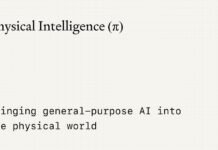“The future belongs to those who believe in the beauty of their dreams,” said Eleanor Roosevelt. This quote resonates deeply as we explore the transformative role of artificial intelligence in shaping modern societies. The rapid advancements in this technology are reshaping industries, economies, and daily routines.
Innovative AI models are now integral to various sectors, from healthcare to transportation. For instance, the first drugs fully generated by artificial intelligence entered clinical trials last year, marking a significant milestone in medical research1. Similarly, autonomous driving technology is expected to achieve a 56% penetration rate by 2030, revolutionizing the way people commute1.
The government’s strategic focus on AI development has fostered a thriving ecosystem. With over 4,500 companies in the AI industry, the core sector is valued at nearly 600 billion yuan2. This growth is driven by cutting-edge platforms and algorithms that enhance efficiency and safety across applications.
As we delve deeper, this article aims to provide insights into the competitive edge of AI advancements. It highlights the role of domestic firms and their innovative approaches in challenging global competitors. Stay tuned to uncover how these technologies are influencing everyday life and shaping the future.
Key Takeaways
- AI models are transforming sectors like healthcare and transportation.
- Autonomous driving technology is set to reach a 56% penetration rate by 2030.
- China’s AI industry includes over 4,500 companies, with a core value of nearly 600 billion yuan.
- Government initiatives are driving rapid growth and innovation in AI.
- Domestic firms are challenging global competitors with advanced platforms and algorithms.
Introduction and Overview of AI in China
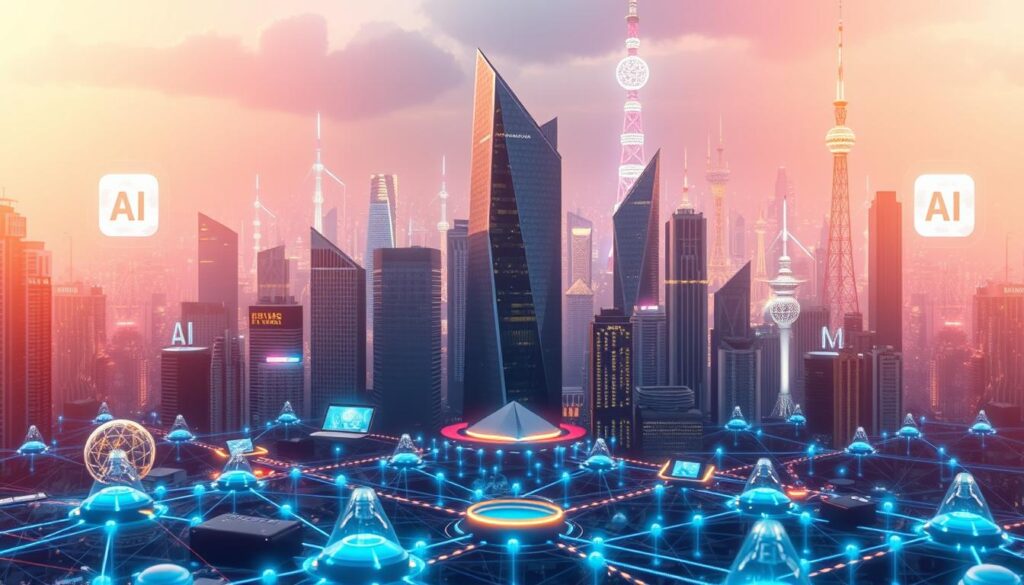
China’s AI ecosystem is a testament to strategic planning and innovation. With over 4,300 companies in the sector, the country has built a robust foundation for artificial intelligence advancements3. This growth is fueled by a unique blend of public policies, private investment, and academic research.
The government plays a pivotal role in driving this progress. Initiatives like subsidies for domestically produced AI chips and financial support for start-ups have accelerated development4. Additionally, the State Council’s national AI teams, comprising major firms like Baidu and Alibaba, have further strengthened the ecosystem5.
Academic institutions such as Tsinghua University have also contributed significantly. Their research has laid the groundwork for cutting-edge algorithms and platforms. This synergy between academia, industry, and policy has positioned China as a global leader in AI.
Technological infrastructure and big data are critical to this success. With 26% of the world’s computing power and a rapidly growing data volume, the country has the resources to train advanced models3. This capability is evident in the narrowing performance gap between Chinese and U.S. AI systems4.
In the following sections, we’ll explore the historical evolution of China’s AI landscape, the role of government initiatives, and the integration of AI in everyday life. Stay tuned to uncover how these advancements are shaping the future.
Historical Evolution of China’s AI Landscape

The journey of artificial intelligence in China began decades ago, rooted in academic research and strategic planning. Early efforts in the late 20th century laid the groundwork for what would become a thriving ecosystem. Returning academics played a pivotal role, bringing global expertise to local institutions.
Institutions like Tsinghua University became hubs for innovation, fostering the development of advanced algorithms and platforms. These efforts were supported by government policies that prioritized technology as a driver of economic growth. By the early 2000s, significant funding increases and policy shifts accelerated progress6.
Early Foundations and Strategic Growth
The origins of AI research in China can be traced back to the late 1980s. Academic institutions focused on foundational research, while the government began to recognize its potential. Strategic initiatives, such as the establishment of national AI teams, further solidified the country’s commitment to this sector6.
Key milestones included the launch of the “Eastern Data, Western Computing” project in December 2023, which aimed to enhance computational capabilities7. This initiative reflected a broader strategy to build a robust infrastructure for AI development. By 2024, China’s computing power network was a critical component of its technological advancement7.
Key Milestones in AI Development
Several breakthroughs marked the rapid expansion of China’s AI landscape. The establishment of the “AI Large Model National Team” in July 2023 highlighted the focus on developing large-scale models7. This effort was complemented by policies like Shanghai’s support for R&D of internationally competitive models7.
Another significant achievement was the launch of the National Integrated Supercomputing Power Scheduling Platform in April 2024. This platform aimed to optimize computational resources, ensuring efficient growth in the sector7. These milestones underscore the country’s strategic approach to becoming a global leader in artificial intelligence.
For more insights into the latest technology advancements, explore our guide on top AI tools shaping industries today.
Government Initiatives and Policies Supporting AI Innovation

Strategic funding and policies have become the backbone of technological advancements in artificial intelligence. The government plays a pivotal role in fostering innovation through targeted subsidies, regulatory frameworks, and guidance funds. These efforts aim to create a robust ecosystem for AI development, ensuring long-term growth and competitiveness.
Government Funding and Subsidies
Public funding is a key driver of AI innovation. The government provides subsidies for domestic semiconductor firms, encouraging the production of locally designed chips8. This approach reduces dependency on foreign technology and strengthens the domestic supply chain.
In Beijing, specific subsidies support the purchase of AI-related hardware and software. These incentives are designed to lower the cost of entry for startups and small businesses8. By reducing financial barriers, the government fosters a thriving environment for AI companies.
Regulatory Environment and Guidance Funds
Regulatory guidance funds play a crucial role in supporting early-stage AI firms. These funds provide financial assistance and mentorship, helping startups navigate the complexities of the market9. Such initiatives ensure that innovative ideas receive the resources needed to succeed.
The spatial distribution of government VC funds is another critical factor. Investments are spread across regions, including inland areas, to promote balanced growth8. This strategy ensures that innovation is not limited to major cities but extends to underserved regions.
The interplay between public policy and private sector investment is essential for sustained growth. Government initiatives create a favorable environment, while private firms drive technological advancements9. Together, they form a powerful synergy that propels the AI sector forward.
While these initiatives offer significant benefits, they also face challenges. Balancing innovation with regulatory oversight remains a complex task. However, the government’s commitment to fostering a secure and efficient AI ecosystem is evident in its strategic approach8.
How is China Using AI in Everyday Life?

From smart homes to urban surveillance, advanced technology is reshaping daily routines across the country. The integration of artificial intelligence into everyday life is becoming increasingly seamless, driven by innovative models and government-backed platforms10.
In digital healthcare, AI-powered tools are revolutionizing patient care. For instance, diagnostic systems powered by advanced algorithms are improving accuracy and efficiency11. These systems are now widely accessible, thanks to government initiatives that promote the development of AI-driven solutions10.
Urban planning has also seen significant advancements. Smart city projects leverage AI to optimize traffic flow, reduce energy consumption, and enhance public safety. These applications are supported by robust infrastructure and big data capabilities11.
At home, smart devices are transforming how people interact with their surroundings. From voice-activated assistants to AI-driven appliances, these products are influencing consumer choices and improving convenience10. The market for such devices is rapidly expanding, driven by innovation and affordability11.
Government-backed platforms play a crucial role in making advanced technology accessible to the public. By investing in research and development, the state ensures that cutting-edge solutions are widely available10. This approach fosters growth and innovation across various sectors11.
As we explore these everyday applications, it’s clear that AI is not just a futuristic concept but a present-day reality. Its influence extends across healthcare, urban planning, and domestic life, shaping the way people live and interact with their environment.
AI Integration in Healthcare: Advancements and Applications

The healthcare sector is undergoing a transformative shift, driven by cutting-edge technologies. Artificial intelligence is at the forefront, revolutionizing diagnostics, treatment, and drug discovery. From early disease detection to personalized medicine, these innovations are reshaping the medical landscape.
Revolution in Medical Imaging and Diagnostics
AI-powered tools are enhancing medical imaging and diagnostics. For instance, an AI model developed in Shanghai has successfully passed the national medical licensing examination12. These systems can process thousands of medical textbooks and compare CT images with high precision, improving diagnostic accuracy12.
In Wuzhen, an AI-empowered hospital has served thousands of patients with fewer than ten human doctors, supported by intelligent triage robots12. This approach not only increases efficiency but also reduces the burden on healthcare professionals.
Personalized Treatment and Drug Discovery
AI is also transforming personalized treatment plans. By analyzing big data, these systems create tailored therapies for patients. For example, AI has improved the diagnostic accuracy of fatty liver from 30% to 5% in liver function tests12.
In drug discovery, AI-powered trials are accelerating the development of new treatments. The National Health Commission (NHC) guidelines cover 84 specific AI application scenarios in the health sector, including medical service management and research12.
State-funded research and industry-academia partnerships are driving these advancements. The Chinese government’s Five Year Plan (2021-2025) prioritizes R&D in medical imaging and personalized medicine, supporting both public and private funding13.
Key benefits of AI in healthcare include:
- Improved early disease detection through advanced imaging12.
- Personalized treatment plans driven by AI analytics12.
- Accelerated drug discovery trials12.
- Reduced healthcare costs and increased treatment efficiency14.
As these technologies continue to evolve, their impact on healthcare will only grow. The integration of AI into medical practices is not just a trend but a necessity for modern healthcare systems.
AI in Transportation and Autonomous Vehicles

The transportation sector is experiencing a revolution, powered by cutting-edge advancements in autonomous technology. Companies like Huawei and Xiaomi are leading the charge, developing innovative systems that redefine urban mobility15.
Autonomous driving is no longer a distant dream. At least 19 cities are currently testing robotaxis and robobuses, with Beijing planning to allow driverless taxis and public buses by April 202515. This rapid progress is driven by advanced algorithms and robust infrastructure.
Innovations in Driverless and Connected Cars
Baidu’s Apollo Go aims to deploy 1,000 robotaxis in Wuhan by the end of 2024, while Pony.ai plans to expand its fleet to over 1,000 vehicles by 202615. These efforts highlight the competitive dynamics in the market.
Pony.ai operates 250 robotaxis across four major cities, covering 2,000 square kilometers. The company has established 3,000 pick-up and drop-off points in Guangzhou and Shenzhen, showcasing the scalability of this technology15.
The Greater Bay Area is being developed as the largest testing ground for self-driving cars, integrating Guangdong, Hong Kong, and Macau15. This initiative reflects the government’s commitment to fostering innovation in the sector.
Future trends emphasize safety and regulatory standards. For instance, the safety level of autonomous driving is reported to be 10 times that of manned driving, addressing concerns about urban mobility16.
Key advancements include:
- Expansion of robotaxi fleets in major cities15.
- Development of advanced driver assistance systems (ADAS) by firms like Horizon Robotics17.
- Integration of AI into urban planning to optimize traffic flow and reduce energy consumption15.
As these technologies evolve, they are reshaping consumer expectations and setting new benchmarks for the global transportation market17.
AI in Education: Personalized Learning and Research
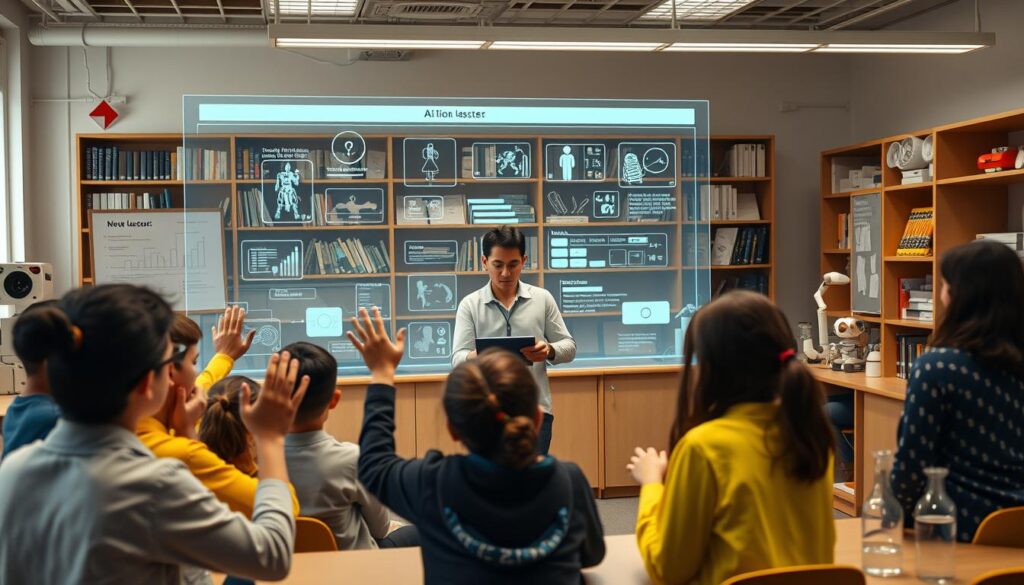
Education is undergoing a digital transformation, with artificial intelligence at its core. Adaptive learning platforms and AI-driven tools are reshaping how students learn, making education more personalized and efficient. These innovations are not just enhancing academic performance but also fostering a deeper understanding of complex subjects.
EdTech Innovations and Adaptive Learning Platforms
Adaptive learning platforms use algorithms to tailor educational content to individual student needs. For example, a study involving 48 undergraduate students showed significant improvements in cognitive skills like memory, attention, and reasoning when using AI tools18. Platforms like Knewton have demonstrated similar success, with students achieving higher engagement and test scores19.
AI-powered chatbots provide 24/7 support, answering questions and offering feedback instantly. This immediate assistance helps students stay on track and improves their self-efficacy18. Additionally, predictive analytics can identify at-risk students early, allowing educators to intervene before issues escalate19.
Partnerships and Long-Term Benefits
Collaborations between EdTech start-ups and traditional institutions are driving innovation. For instance, Georgia State University’s AI-driven system increased graduation rates by 3% and saved students $12 million in tuition costs19. These partnerships ensure that cutting-edge technology reaches a broader audience, benefiting both students and educators.
AI also plays a crucial role in research, helping academics process large datasets and generate hypotheses. This integration accelerates discoveries and enhances the quality of academic work19.
Key benefits of AI in education include:
- Personalized learning paths that adapt to individual performance18.
- Improved student engagement and motivation through interactive tools18.
- Enhanced teaching efficiency with automated grading and feedback systems19.
- Early identification of at-risk students for timely intervention19.
As AI continues to evolve, its role in education will expand, offering even more opportunities for personalized learning and innovative research. The future of education is here, and it’s powered by artificial intelligence.
Economic Impact: Investment, Market Growth, and Competitive Landscape
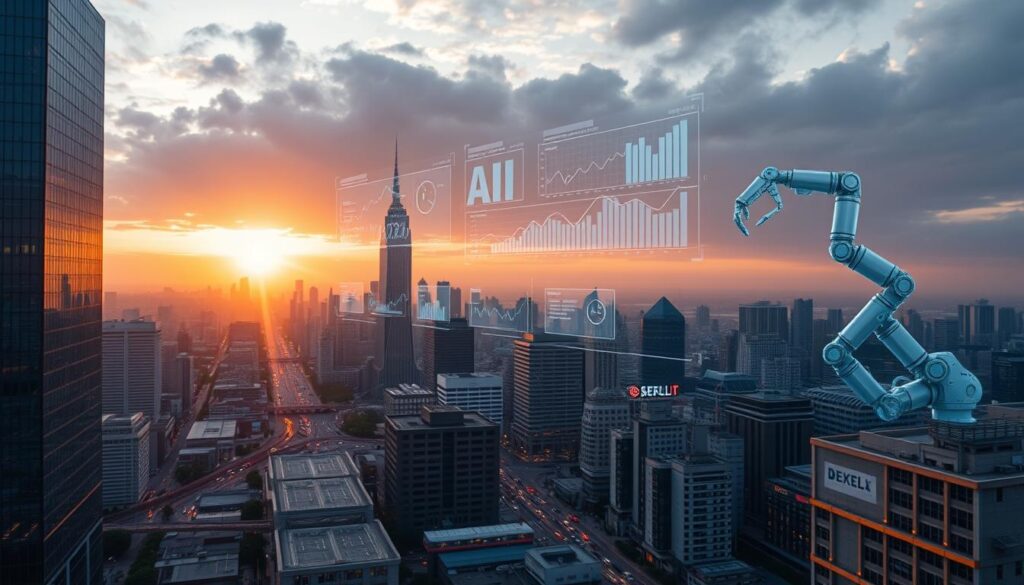
The economic landscape is being reshaped by significant investments in advanced technologies. Venture capital and private funding are driving rapid growth, particularly in emerging sectors. This section explores the trends, competitive pressures, and future opportunities in this dynamic market.
Venture Capital and Private Investment Trends
Global venture capital investment in AI over the past decade totals $846 billion, with $220 billion invested in China20. This surge reflects the growing confidence in the potential of advanced technology. Private investment in generative AI in China surged from $650 million in 2023 to approximately $3.15 billion in 2024, marking an almost five-fold increase21.
China’s investments are projected to contribute an additional $7 trillion to its GDP by 203020. This growth is fueled by both private and public funding, with the government playing a pivotal role in bridging investment deficits. For instance, the “Interim Measures for the Management of Generative Artificial Intelligence Services” issued in 2023 provided clear guidance for AI development and governance21.
Competitive Pressures and Emerging Sectors
Competitive pressures are reshaping the investment landscape. Firms like Baidu and Huawei are leading the charge, with Baidu’s ERNIE Bot holding an 11.5% market share as the most frequently used generative AI product among domestic users21. Huawei Cloud’s Ascend service reduced large model training development time from five months to one month, showcasing the efficiency of these innovations21.
Emerging sectors such as healthcare and urban planning are benefiting from these advancements. For example, MedGPT AI Doctor by Yilian has demonstrated capabilities comparable to human doctors in real-world testing21. These applications highlight the transformative potential of AI-driven solutions.
Future Economic Opportunities
The future holds immense economic opportunities. Cloud adoption in China is expected to increase from 10% in 2022 to 35% in 2030, with a CAGR of 29%20. This growth will drive demand for advanced algorithms and platforms, creating new avenues for innovation.
To explore how these technologies are shaping industries, check out our guide on making money with AI. As the market evolves, the integration of AI into various sectors will continue to unlock unprecedented economic potential.
Advancements in AI Research and Technology Development
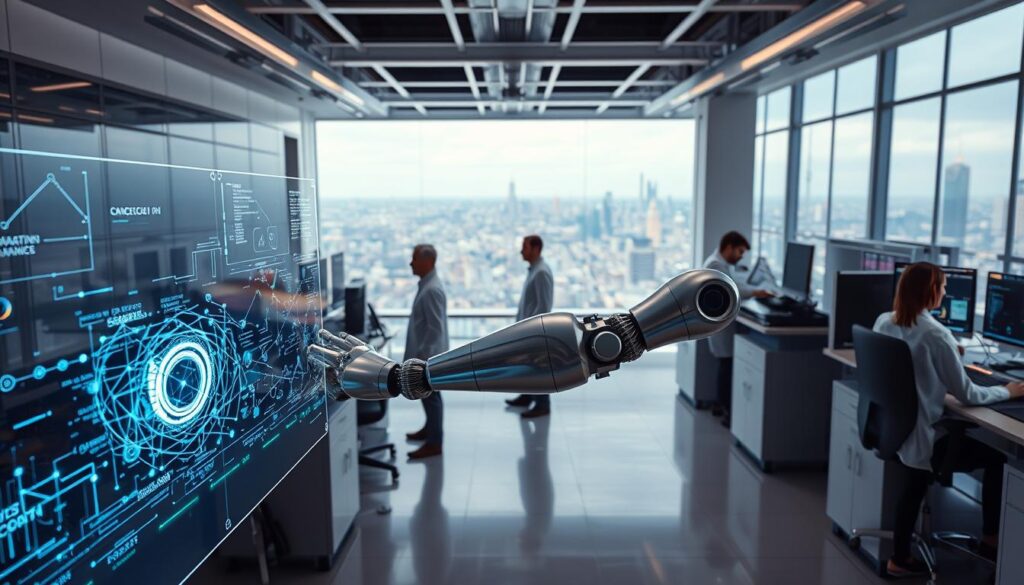
Breakthroughs in AI research are setting new benchmarks globally, with significant contributions from both private firms and academic institutions. These advancements are reshaping industries and driving innovation across various sectors.
Generative AI Models and Benchmark Performance
Generative AI models are achieving remarkable milestones, with Chinese labs like Alibaba and Zhipu AI leading the charge. For instance, the SuperCLUE benchmark highlights the narrowing performance gap between Chinese and U.S. models22. This progress is fueled by extensive research and robust funding.
In 2020, China produced 23% of global Science and Engineering publications, while the U.S. accounted for 16%22. This reflects the growing influence of Chinese technology in the global AI landscape. The collaboration between academia and industry has been pivotal in achieving these results.
Open-Source Innovations and Academic Contributions
Open-source platforms are accelerating innovation by fostering collaboration among researchers worldwide. Institutions like Tsinghua University are at the forefront, developing advanced algorithms that are freely accessible to the global community23.
The integration of AI into curricula at prestigious universities such as Renmin University of China and Shanghai Jiao Tong University is also driving progress23. These efforts are preparing the next generation of AI experts, ensuring sustained growth in the field.
China aims to become a global leader in artificial intelligence by 2030, focusing on expanding AI across various sectors. This strategic vision is supported by both public and private investments, creating a thriving ecosystem for development.
Case Studies of Leading Chinese AI Companies

The rapid rise of Chinese AI companies is reshaping the global tech landscape. These firms are not only innovating but also challenging established global leaders. This section explores the journeys of Zhipu AI, Moonshot AI, and other emerging players, highlighting their contributions to the field.
Zhipu AI and Emerging Start-ups
Zhipu AI has emerged as a key player in the generative AI space. With over 100 large language models competing in the country, Zhipu AI stands out for its cutting-edge algorithms and innovative models24. The company has achieved unicorn status, showcasing its rapid growth and market impact.
DeepSeek, another notable start-up, claims its latest model outperforms closed-source models like GPT-4 Turbo in coding and math benchmarks24. This demonstrates the innovation driving these firms, positioning them as serious competitors on the global stage.
Insights from Moonshot AI and Industry Leaders
Moonshot AI is another example of a Chinese firm making waves. Its focus on advanced technology and research has led to significant breakthroughs. The company’s ability to secure substantial funding reflects investor confidence in its potential24.
University incubators, such as those at Tsinghua University, have played a crucial role in spawning these ventures. These institutions provide the necessary datum and infrastructure for start-ups to thrive25.
| Company | Focus Area | Key Achievement | Funding Status |
|---|---|---|---|
| Zhipu AI | Generative AI | Unicorn status | Substantial funding |
| Moonshot AI | Advanced Technology | Breakthrough algorithms | Investor-backed |
| DeepSeek | Coding & Math Benchmarks | Outperforms GPT-4 Turbo | Rapid growth |
These companies are not just innovating but also influencing global trends. For more insights into how AI is transforming industries, explore our guide on AI in finance.
Data, Compute, and Infrastructure Powering AI Innovation

The foundation of AI innovation lies in robust data and advanced computing platforms. These elements are critical for training sophisticated models and driving breakthroughs in the field. Without vast data resources and cutting-edge infrastructure, the progress we see today would not be possible.
The Role of Big Data in AI Training
Big data plays a pivotal role in enhancing the accuracy and efficiency of AI systems. The more data an algorithm processes, the better it performs. This symbiotic relationship between data and AI is evident in applications ranging from healthcare diagnostics to autonomous driving26.
For instance, structured, high-integrity data is essential for the next leap in AI capabilities. This ensures that models can handle complex tasks like processing multi-year datasets or entire libraries of books in a single query26.
Advanced Computing Platforms and On-Premises Solutions
Investments in advanced computing platforms are accelerating AI development. Companies like Huawei are leading the way with on-premises solutions such as their “AI-in-a-box” products. These platforms provide the computational power needed for high-performance training26.
By 2030, over 80 GW of new data center demand could be deployed in the United States, consuming well over 400 TWh of electricity annually27. This highlights the growing need for robust infrastructure to sustain AI innovation.
Key advancements include:
- GPU clusters that enable faster processing of large datasets27.
- On-premises solutions that reduce dependency on cloud services26.
- Scalable infrastructure that supports future AI demands27.
As AI continues to evolve, the demand for more powerful compute resources will only increase. Ensuring access to cutting-edge technology and infrastructure will be essential for maintaining a competitive edge in the global AI landscape.
Challenges in Ethics, Security, and Global Competition

The rapid expansion of AI technologies brings both opportunities and challenges, particularly in ethics, security, and global competition. As these systems become more pervasive, concerns about data misuse, user privacy, and surveillance have come to the forefront. Balancing innovation with robust security measures remains a critical issue.
Balancing Innovation with Privacy and Security
One of the most pressing ethical challenges is the potential misuse of data in AI-enabled systems. For instance, the integration of AI into surveillance technologies raises questions about privacy and individual freedoms28. Regulatory responses, such as the EU’s AI Act, aim to mitigate these risks by setting strict guidelines for data usage28.
Another concern is the tension between rapid innovation and the need for robust security measures. While advancements in technology drive progress, they also introduce vulnerabilities that can be exploited. For example, AI-powered cyberattacks pose significant threats to both public and private sectors28.
Legislative and policy adjustments are being made to address these issues. The U.S. has implemented export controls on AI-relevant semiconductors to limit access to sensitive technology29. Similarly, China is investing in domestic semiconductor manufacturing to achieve self-sufficiency29.
Global Competitive Pressures
The race for AI dominance is intensifying economic competition, particularly between major players like the U.S. and China. This rivalry drives innovation but also fuels controversy over ethical standards and governance28.
Key challenges include:
- Developing robust AI governance frameworks to ensure fairness and transparency28.
- Investing in AI safety research to address vulnerabilities28.
- Promoting international cooperation to tackle global AI challenges29.
As the government and private sector navigate these complexities, the focus remains on fostering a secure and ethical AI ecosystem. The global community must work together to ensure that advancements in technology benefit society as a whole.
Chinese AI’s Global Influence and Strategic Power

China’s advancements in artificial intelligence are reshaping global markets and strategic power dynamics. With over 50 companies developing large language models (LLMs) since the release of ChatGPT, the country is positioning itself as a leader in AI innovation30.
Chinese AI models are narrowing the performance gap with their U.S. counterparts, though they currently require four times the computing resources to achieve similar results30. This effort is supported by significant government investments in technology and research, aiming to enhance economic competitiveness and military capabilities30.
Strategic initiatives like the Belt and Road Initiative (BRI) highlight China’s focus on extending its influence abroad. For example, agreements with Pacific Islands and infrastructure projects in the Solomon Islands demonstrate the country’s commitment to economic engagement and strategic power31.
Chinese AI firms are also exporting their technology globally. Companies like DeepSeek are competing with top U.S. models at a fraction of the cost, making their solutions accessible to international markets32. This approach not only boosts China’s global presence but also challenges Western dominance in the AI sector.
To explore how these advancements are shaping industries, check out our guide on AI tools revolutionizing the game.
As China continues to invest in AI, its influence on global markets and strategic power will only grow. The country’s ability to balance innovation with strategic initiatives positions it as a counterbalance to Western AI leadership.
Exploring Future Trends and Development Strategies
The future of technological innovation hinges on sustainable strategies and forward-thinking approaches. As the global landscape evolves, the focus shifts toward creating a roadmap for long-term growth in the AI sector. This involves addressing challenges, leveraging opportunities, and fostering collaboration between key stakeholders.
Roadmap for Sustainable AI Growth
A detailed roadmap is essential for guiding the future trajectory of AI innovation. Strategic areas include increased investment in R&D and talent development. By 2028, robots are expected to break into the mass market, signaling a new era of technological integration33.
Scaling AI applications presents both challenges and opportunities. For instance, advancements in healthcare, such as analyzing protein structures, highlight the potential for transformative impact33. However, sustainable practices must be prioritized to ensure responsible growth.
The government and private sector play crucial roles in fostering an innovative ecosystem. Policies that support domestic technology development, such as subsidies for AI-related hardware, are vital33. Collaboration between companies and academic institutions further accelerates progress.
Key strategies for sustainable growth include:
- Investing in advanced algorithms and computing platforms34.
- Promoting ethical AI practices to address privacy and security concerns.
- Encouraging international cooperation to tackle global challenges.
As the sector evolves, the focus will remain on balancing innovation with sustainability. This approach ensures that AI continues to drive economic and societal benefits while addressing emerging challenges. For more insights into the latest advancements, explore our guide on AI development in China.
Policy Recommendations for the United States on AI Competition
To maintain a competitive edge in AI, the United States must adopt strategic policies that foster innovation and investment. The global race for AI dominance demands a proactive approach, combining private sector dynamism with robust federal support. Below are actionable recommendations tailored to U.S. policymakers, drawing on global trends and industry insights.
Stimulating Private Investment in AI R&D
Private sector investment is crucial for advancing AI technologies. The U.S. government should incentivize companies to increase their R&D spending through tax credits and grants. Over the past five years, the U.S. has committed just over $12 billion to AI-related obligations, primarily for R&D35. Expanding these initiatives will accelerate innovation and ensure the U.S. remains a leader in AI development.
Public-private partnerships can also play a pivotal role. By collaborating with academic institutions and tech firms, the government can bridge gaps in funding and expertise. This approach will foster a thriving ecosystem for AI innovation.
Enhancing Federal Support and Digital Transformation
Federal agencies must prioritize digital transformation to leverage AI effectively. A revitalized funding framework dedicated to AI innovations is essential. This includes investing in advanced technology infrastructure and streamlining regulatory processes to preserve competitive advantage.
An expansive national data strategy is another critical component. High-quality datum is the backbone of AI model training. By creating a centralized data repository, the U.S. can ensure that researchers and companies have access to the resources they need35.
Additionally, integrating AI into governmental operations can improve efficiency and decision-making. For example, AI-powered tools can enhance public services, from healthcare to transportation. This transformation will not only boost productivity but also set a precedent for other nations.
For more insights into how AI is shaping the future, explore our guide on the rise of artificial intelligence.
Conclusion
The rapid evolution of technology is reshaping industries and global dynamics. From healthcare to transportation, advancements in algorithm-driven systems are transforming everyday life. The role of the government in fostering innovation cannot be overstated, with strategic investments driving progress.
Competitive dynamics between leading nations highlight the importance of ethical and strategic development. As companies continue to push boundaries, the need for robust datum and secure infrastructure becomes critical. These elements are essential for training advanced models and ensuring sustainable growth.
Looking ahead, collaboration between policymakers and industry leaders will be key. Addressing challenges in privacy, security, and global competition will shape the future of this field. A forward-thinking approach ensures that innovation benefits society while maintaining ethical standards.
Encouraging further research and dialogue is crucial. By fostering a balanced ecosystem, we can unlock the full potential of these transformative technologies. The journey ahead is both challenging and promising, offering endless opportunities for progress.
FAQ
What role does the Chinese government play in AI development?
How is AI transforming healthcare in China?
What are the key applications of AI in transportation?
How does AI impact education in China?
What are the economic benefits of AI in China?
What challenges does China face in AI development?
How does China’s AI strategy influence global markets?
What are the future trends in Chinese AI?
How does infrastructure support AI innovation in China?
What lessons can the U.S. learn from China’s AI strategy?
Source Links
- How AI is shaping industries in China | J.P. Morgan Research
- AI making presence felt in China like never before
- How Innovative Is China in AI?
- Artificial intelligence industry in China
- China’s AI Surge Could Impact the Global Business Landscape, Experts Say | PYMNTS.com
- China’s AI development model in an era of technological deglobalization
- AI Capacity-Building Action Plan for Good and for All_Ministry of Foreign Affairs of the People’s Republic of China
- China’s Views on AI Safety Are Changing—Quickly
- From chatbots to intelligent toys: How AI is booming in China
- AI seeps into everyday life in China
- China embraces AI-assisted healthcare with caution
- AI in Chinese healthcare: From medical imaging to AI hospitals
- Exploring the Impact of Artificial Intelligence on Global Health and Enhancing Healthcare in Developing Nations
- China goes full throttle on driverless vehicle use – International Finance
- Autonomous driving shifts into high gear in China
- Horizon Robotics and the Rise of Chinese AVs / Real World AI (Tech Strategy – Podcast 240) – Jeffrey Towson 陶迅
- Exploring the impact of artificial intelligence application in personalized learning environments: thematic analysis of undergraduates’ perceptions in China – Humanities and Social Sciences Communications
- AI in Education: Personalized Learning and Improved Educational Outcomes
- Greater China Insights—China’s AI Growth Multiplier
- China And AI In 2025: What Global Executives Must Know To Stay Ahead
- China and the U.S. produce more impactful AI research when collaborating together – Scientific Reports
- Integration of tech with social life drives Chinese people’s enthusiasm for AI
- China’s Domestic AI Competition Heats Up
- Chinese AI applications now have bigger aims — they’re looking beyond chatbots
- AI: The Battlefield In The War For Data Control
- Securing Full Stack U.S. Leadership in AI
- The Great AI Race: China, Deepseek, and the Global Quest for Supremacy – and its risks
- Competition, Not Control, is Key to Winning the Global AI Race
- China’s AI future in a quest for geopolitical, computing and electric power
- Understanding the PRC Grand Strategy AI Model: China’s Strategic Vision Decoded
- The Real Threat of Chinese AI
- 4 Key Trends Shaping China’s Future: From AI To Robots
- China’s Generative AI Ecosystem in 2024: Rising Investment and Expectations
- Stakes Rising In The US-China AI Race


